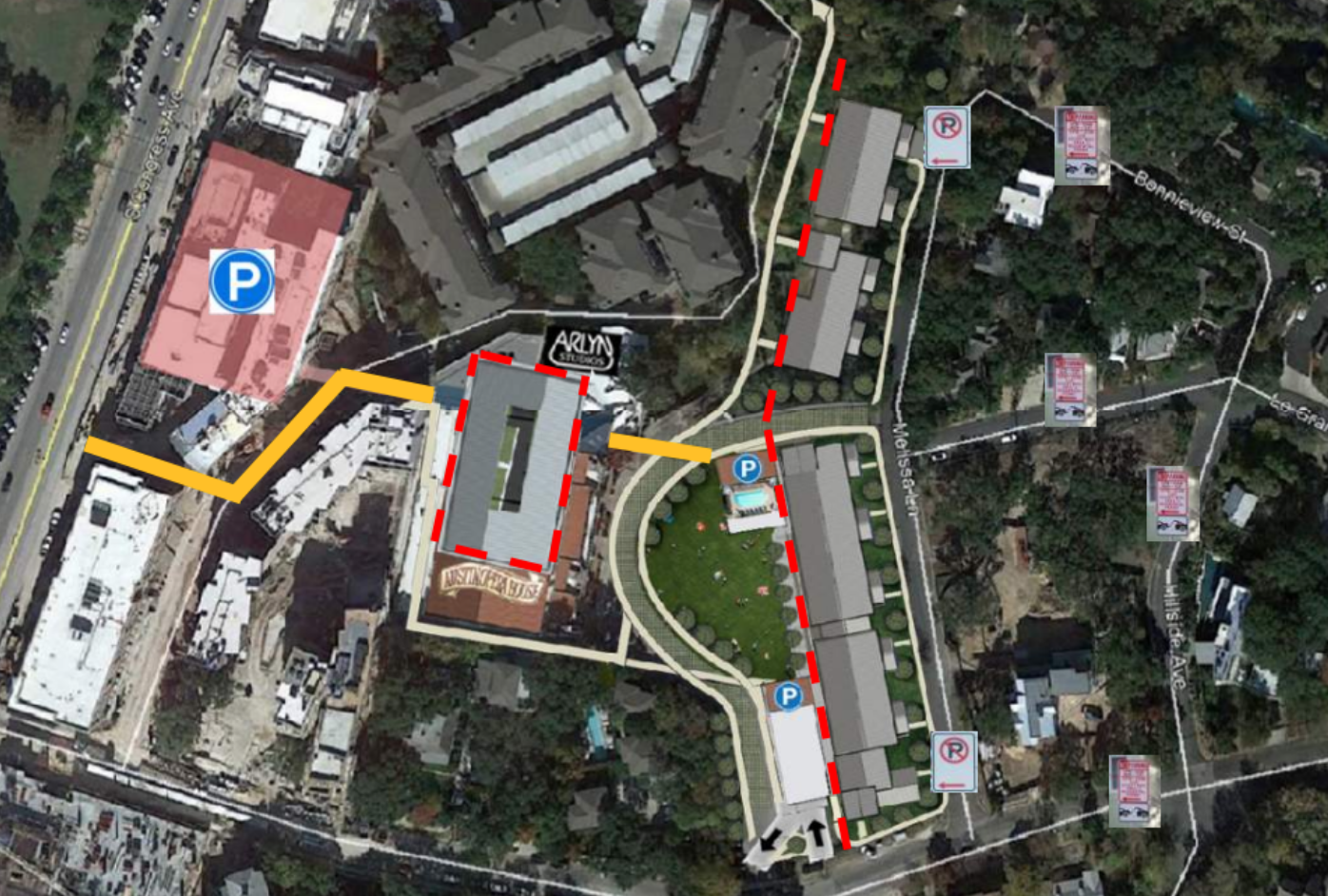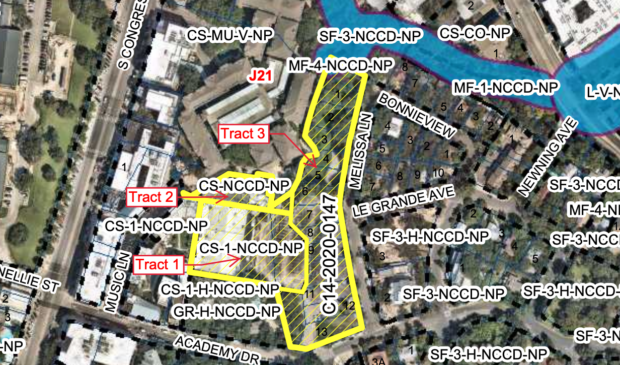Rezoning to bring back Austin Opry House headed for Council vote
Friday, October 15, 2021 by
Jonathan Lee The revival of storied music venue Austin Opry House moved one step closer to reality Tuesday when the Planning Commission recommended rezoning the site at 200 Academy Drive to make way for a mixed-use development. Beyond reviving the 1,200-capacity venue, plans include a museum of Austin music, 100 residential units, commercial space and a public park.
Before the project can move forward, the Fairview Park NCCD, a historic overlay intended to preserve the adjacent single-family neighborhood, needs to be removed. The NCCD is a big reason why the 4.6-acre site has sat underused since the Austin Opry House closed in 1992; now, there exists only offices and the city’s “largest historically zoned parking lot,” according to applicant Richard Weiss. The NCCD essentially restricts any construction to two-story homes, and the venue itself even violates the NCCD, which was put in place after it was built.
“We are using a preservation tool as a weapon to destroy the preservation of one of the most iconic music venues that we’ve ever had in this town,” said Eric Van Hyfte, a neighbor in favor of the rezoning.
The Austin Opry House, which was partially owned by Willie Nelson for a time, hosted many world-renowned acts during its two-decade run. It also helped propel local artists like Stevie Ray Vaughan to fame. Freddy Fletcher, Willie Nelson’s nephew and founder of Arlyn Studios, told the commission that “reopening the Opry House will … show we support what we find is the Live Music Capital of the World.”
The venue’s demise, combined with the passing of similar venues like Armadillo World Headquarters, created a “very specific void” in Austin’s music ecosystem that persists today, said Will Bridges, co-owner of Antone’s Nightclub. “Austin currently does not have a single indoor standing-room music venue between 700 capacity and 1,700 capacity.” Bridges said this gap prevents many local artists from becoming national acts.
While the prospect of a revived Austin Opry House may delight music fans and musicians, it has faced strong pushback from neighbors such as Laura Toups, the former president of the Congress for the New Urbanism Central Texas Chapter. Toups, who said the venue would have “a tremendous effect on the neighborhood,” also took issue with the city’s traffic impact analysis; she thinks the project would create much more traffic than staffers project.
The commission heard the case a month ago, but voted to give Weiss and the neighbors more time to find common ground.

A site plan, presented at the meeting by applicant Richard Weiss.
In response to neighbors’ concerns, Weiss mentioned several measures the project will take to keep pedestrians and cars out of the single-family neighborhood:
- A pedestrian promenade leading concertgoers toward South Congress Avenue, where Project Connect’s Orange Line is planned
- 900 parking spaces between the planned underground garage and the existing Music Lane parking garage
- Dedicated ride-share drop-off and pickup in the garage plus drop-off and pickup on Music Lane and Congress
- Right-turn only from the garage onto Academy Drive, forcing cars toward Congress
- Over $340,000 in traffic improvements, including sidewalks and a pedestrian hybrid beacon at East Riverside Drive and Newning Avenue
- Support for a residential parking permit plan to keep concertgoers from parking on the street
Toups was also concerned that the venue would be open until midnight or 2 a.m. Weiss said there are no plans to stay open that late. “We’re not intending to be a nightclub; we’re intending to be a music venue,” Weiss said, without stating a specific closing time.
Weiss noted that the four-story multifamily project would serve as further insulation between the single-family neighborhood and the concert hall. Toups said she supports new housing, just not the music venue unless it is smaller than 2,500 square feet.
Commissioners were split. Some supported the project as proposed, while others sided with the neighbors in opposition.
“I really do agree with the applicant on the need for a venue of that size,” Chair Todd Shaw said. “I just don’t think this is the right place.” Shaw made a motion to cap the venue at 5,000 square feet, but it failed 3-6-1.
Commissioner Grayson Cox, while also concerned about the venue size, voted to recommend the rezoning as requested apart from a few minor changes. “I just would hate to see this opportunity go to the wayside to preserve this music venue and all its history,” Cox said.
If City Council approves the rezoning, the Planning Commission will get the final say on the venue size because it is a conditional use. At that point, the commission could restrict occupancy and hours of operation. The Council date has not yet been set.
A smaller occupancy limit would mean altering the space, something Weiss wants to avoid in order to preserve the character and history of the original Austin Opry House. “The sounds that reflected on these very walls brought thousands of musicians, me included, to the Live Music Capital of the World,” he said.
The Austin Monitor’s work is made possible by donations from the community. Though our reporting covers donors from time to time, we are careful to keep business and editorial efforts separate while maintaining transparency. A complete list of donors is available here, and our code of ethics is explained here.
You're a community leader
And we’re honored you look to us for serious, in-depth news. You know a strong community needs local and dedicated watchdog reporting. We’re here for you and that won’t change. Now will you take the powerful next step and support our nonprofit news organization?







